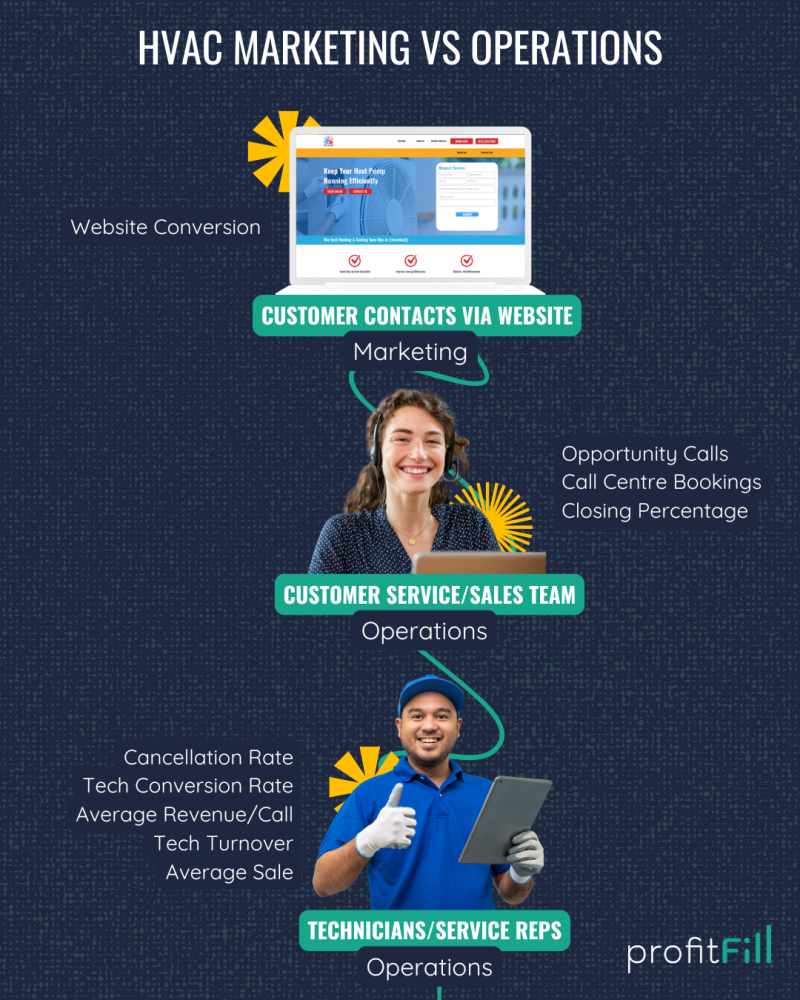Securing a conversion at the lowest possible cost is the job of your marketing team or agency, but turning that conversion into the highest possible revenue is the responsibility of the HVAC company. If your Operations team is not able to take the conversion and turn it into substantial revenue, then the marketing team will never be able to secure conversions at a low enough cost to be profitable.
Your call centre needs to book the call, your dispatch team needs to get the right technician to the call and your technician needs to convert the call into a repair or a lead. The salespeople need to close leads with a high sales conversion percentage and a high average sale price. If one of these functions in your operations team is not performing, you will not be in a position to compete for Search Engine Marketing (SEM) leads. This is because a competitor who is producing more revenue from the conversion will always be willing to pay more for that conversion.
As a general rule, you should count on allocating 5-7% of your sales to marketing to maintain your level of sales and to possibly have some marginal growth. You should plan to spend 8-10% of your sales on marketing if you wish to have a 10% growth in your business. You should plan to spend 10-15% of sales on marketing if you wish to grow your business by 10% or more. Most owners are surprised to hear that you need to spend so much money on marketing. The fact of the matter is that marketing is the fuel your business needs to grow. Without a strong emphasis on marketing, your residential HVAC business simply can’t grow at the same rate as a company with a sharp and aggressive marketing program.
It is critical that you have all the data to understand that your operations are working and producing profitable jobs. So many times a company will blame their marketing team because the cost of marketing percentage is too high when really the problem is that their operations are not creating enough revenue from the conversions.

Let’s walk through the operations functions in an HVAC company and examine the role they play in a profitable Search Engine Marketing campaign. You will need to know the following metrics.
Opportunity Calls
This is a call that the CSR has an opportunity to book. It is an inquiry for a service the company offers and it is in the geographic area and during hours the company serves. In other words, the CSR should be able to book this call on the schedule.
Non-Opportunity Calls
These are calls that the CSR has no opportunity to book. These would be for inquiries for services not offered by the company or outside the service area or service hours. They would also include sales solicitations etc.
Opportunity Calls vs. Non-Opportunity Calls as a Percentage
It is important to know this ratio as too many non-opportunity calls could mean your ads are targeting users outside your geographic zone or are targeting users who are searching for a service you don’t offer. This will obviously affect the profitability of the campaign as you’re paying for clicks and calls that you have no possibility of converting to revenue.
Replacement Opportunities
A replacement opportunity is an opportunity where the equipment at the home meets or exceeds the age determined to be a replacement opportunity.
Non-Replacement Opportunities
This is a call where the equipment at the home is newer than the age determined to be a replacement opportunity.
Replacement Opportunity Calls vs Non-Replacement Opportunity Calls
This metric shows how well your marketing team is targeting the best geographic zones and the best keywords in order to uncover replacement opportunities.
Call Centre Booking Percentage on Opportunity Calls
This metric tracks how efficient your call centre is at booking calls This is simply the percentage of conversions that your call centre books into the schedule as booked jobs divided by the number of opportunity calls. This is the first critical metric to gauge your operations.
Cancellation Rate
Not all booked calls end up being jobs attended by a technician. Your cancellation rate is usually indicative of two operational functions: how quickly you are able to provide service and how competitive your diagnostic fee is. While there are many reasons why someone would book a call and then cancel, the two big ones are: they found someone to help them sooner or they found someone to help them cheaper.
If your cancellation rate is more than 20%, you need to have a close look at your diagnostics fee or you need to see how far out you are booking jobs because clients are usually cancelling for one or both of these reasons. A lot of companies have a very high diagnostics fee of $100 – $150 or even more. This is fine as long as your cancellation rate is not too high and your call centre booking rate is good. 20% will be our cancellation rate.
Your call centre booking rate is a number that most companies track. The question is what is the right number. In our experience, 80% booking is the benchmark for most successful companies and some are even higher. 80% will be our Call Centre Booking Rate.
Tech Conversion Rate
Once the company has managed to get the tech to the home, the technician needs to close the repair or set a replacement lead. More often than any company ever wants to admit, this does not happen and the tech leaves with a diagnostics fee or no money at all. You need to know this number and you need to know why it is happening.
Average Revenue Per Service Call
This is the total revenue from all service calls divided by the number of service calls attended. It does not include any revenue from any subsequent replacements that result from the service call.
Tech Turnover Rate per Replacement Opportunity
The technicians need to turn over a significant percentage of replacement opportunities to the Sales Department. If the service department does not turn over enough leads then the company will not generate enough revenue per service job to justify the cost of the conversion.
Sales Team Closing Percentage On Tech Leads
Sales leads set by technicians are the best leads and should close at a very high rate. The closing percentage is the number of closed leads divided by the total leads set by the techs.
Average Sale on Tech Lead This is the total dollars of all sales from leads divided by the number of leads.
Revenue Per Completed Job vs Revenue Per Booked Job
To find the revenue per booked job, calculate the revenue per completed job you need to use all the revenue generated from your furnace repair jobs including the replacement revenue. In our example, we converted the repair job into a replacement job. The easiest way to calculate this metric is to take all the revenue from your completed repair jobs including any replacement revenue and divide this total by the number of repair jobs you completed. Let’s say that this number is $600, $600 is our Average Revenue Per completed Job. The problem with focusing on your Revenue per completed job is that you skip past critical metrics that tell you how well your operations are performing—your technician closing rate.
We know that not all jobs the technician runs result in revenue so we need to know the technician closing rate. If we were to simply apply the 10% marketing cost per job to the $600 revenue per completed job, this would over-inflate the amount we are prepared to pay for a booked job. We need to apply the technician’s closing rate to revenue per completed job in order to get the revenue per booked job. Let’s say your technicians close calls at 80%. This means that 80% of the calls your technicians run result in revenue.
80% is your Technician Conversion Rate. ( Revenue per completed job x technician closing rate = revenue per booked job. ) Using our example of $600 x 80% = $540 revenue per booked call.
–
ProfitFill combines all of your website, marketing and CRM data into one dashboard to train our algorithm to bring in better, more profitable leads. Learn more about ProfitFill online.





